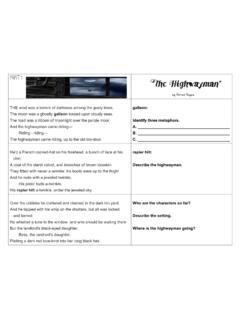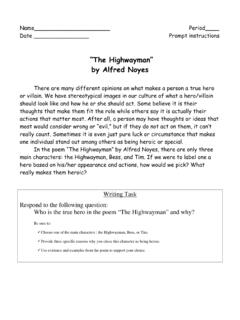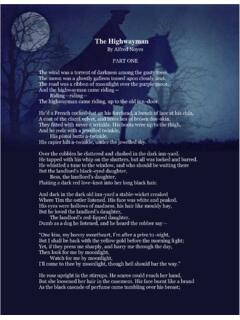Transcription of GEORGE LYON HIGHWAYMAN - The Historic Society of ...
1 GEORGE LYON HIGHWAYMAN ?EORGE LYON was born in Up Holland in 1761. His body vJ was buried in the village churchyard in 1815. He received little or no education. He spent his early life as a labourer and later he became a fully qualified handloom weaver. Why is it that practically every person in the Wigan area knows some- thing about Lyon ? Why is it that people still visit the churchyard at Up Holland to see his grave? The answer lies in Lyon's spare-time activities. Some writers have built up a romantic legend describing GEORGE Lyon as a HIGHWAYMAN : the resultant picture is of a horseman haunting the highways of the Wigan area, robbing the rich who rode in stage coaches in order to give to the poor of Up Holland.
2 The writer believes that this view of Lyon is false, and the 150th anniversary of Lyon's death seems an appropriate time to attempt to put the record early as March 1786, when Lyon was 25, we find him at the Lancaster Assizes. Described as a labourer, he was accused of robbery with violence. Lyon was found guilty of "feloniously apaueling Robert Smith in the King's Highway at the Parish of Wigan and robbing him of Sixteen Shillings his Property".(1) Here lies the seed from which sprang the highly coloured legend of GEORGE Lyon as a HIGHWAYMAN . In recorded conversation later, Lyon declared that the sum involved was 95 guineas, and that he had shielded his accomplices.
3 (2) At any rate, Lyon was found guilty and sentenced to death by hanging. The Manchester Mercury of 11 April 1786 says: "On Thursday the Assizes ended at Lancaster on the Crown side, when .. GEORGE Lyon, for robbing Robert Smith, at Winstanley .. [was] capitally convicted, and received Sentence of Death .." He was reprieved, however, and pardoned, on condition that he be "transported for 7 years".Acts passed during the reign of GEORGE II required those responsible for transporting criminals to enter into a formal contract. It has proved impossible to trace Lyon in the Home Office lists of persons transported, but it is probable that he spent his seven years in Africa.
4 (Lyon himself declared at the time of his later trial that he had been transported see below.)111 Lancaster Assize Records, March 1786, (2> "jhe Trial at Large of GEORGE Lyon, David Bennett and William Houghton on an indictment for a burglary, committed at Westwood House, the Residence of Charles Walmesley Esq."235236 GEORGE LYON HIGHWAYMAN ?Plate 23 PORTRAIT REPUTED TO BE OF GEORGE LYONGEORGE LYON HIGHWAYMAN ? 237If Lyon served his full sentence, his return to England coincided with the outbreak of the French wars (1793). GEORGE settled down to master the art of weaving (at Lyon's trial in 1815, Luke Bradshaw declared that he had been apprenticed to GEORGE Lyon for nearly ten years), but he was far from being a reformed character: thus in a letter written by Ellen Weeton to Mrs.)
5 Whitehead and dated 23 May 1809 she says: "In two houses near together [in Up Holland] there have been in each, a mother and daughter lying-in, nearly at the same time; and one man (the notorious GEORGE Lyon) reputed to be father of all four."For several years before 1814 Lyon (who referred to himself as "King of the Robbers") and his "desperate gang" (essentially his younger friends, David Bennett and William Houghton) committed the most daring depredations and eluded the vigilance of the local authorities. He is said to have boasted that the hemp had not been grown nor the rope "twun" that would fit his neck. The Calender of Crown Prisoners at Lancaster declares that GEORGE Lyon was on 15 October 1814 "charged with having burglariously broken and entered the dwelling house of Peter Robinson, at Wigan, and with having stolen therein, a silver watch, a pair of sheets and divers other articles, his property, also, with having burglariously broken and entered the dwelling house of Charles Walmesley, at Ince within Makerfield, and with having stolen therein, a silver tea chest, a silver basin and divers other articles, his property.
6 Also, with having burglariously broken and entered the dwelling house of John Fogg, at Wigan, and with having stolen therein, a silver tankard, a silver pint and other articles, his property: also, with having stolen a silver watch, a gold chain and various other articles, the property of Henry Gaskell, at Wigan: and also, with having stolen a silver watch, two guineas, five half guineas, a pair of silver buckles and a gold ring, the property of Robert Yates, at Wigan".The Lancaster Gazette mentions eleven indictments against Lyon but he was tried and convicted on two of them, robbing Fogg and eye-witness account of the trial printed in Wigan in 1815 and to be seen in Wigan Reference Library gives full details of the gang's last job, which must be regarded as 6 August 1814, Charles Walmesley and his family left their home Westwood House at Ince-in-Makerfield, near Wigan, to spend a week at North Meols, near Southport.
7 A young man named Edward Ford, who knew the servants, provided GEORGE Lyon with information. Ford joined Bennett,238 GEORGE LYON HIGHWAYMAN ?Houghton and Lyon at the latter's house in Up Holland to plan a the agreed night Ford and Houghton set off at 7 On their way they called at the Hare and Hounds in Pemberton. There they had a drink and something to eat. Whilst there they stole a pair of "quarter boots", the property of the landlord's son. Then the two set off to meet Lyon and Bennett, as arranged, at Parson Meadow Bridge, half a mile from Westwood House. They approached the house and hid in the shrubbery until the servants retired to bed.
8 At 1 all the lights were out in the house. Lyon checked his equipment four pistols loaded with powder and ball, two or three bludgeons, skeleton keys, two iron "rooks" ( small iron crow-bars), and two or three picklocks. Two ladders were borrowed from the barn and tied together. After some difficulty, the robbers succeeded in making an entry to the drawing-room by breaking a catch on the window. Bennett searched and put valuables into his handker- chief. Houghton held a lantern. Ford pocketed three half- crowns. Meanwhile, Lyon performed the lowly task of keeping watch not in itself a role in keeping with the romantic legend. (It is interesting, also, to note that the thieves walked from Up Holland to Ince and back a distance of some ten miles: if they had possessed horses they might have been expected to use them on the job.)
9 We must assume that Lyon and his companions did not own horses, and the picture of Lyon as a velvet-clad HIGHWAYMAN riding a black horse and stopping stage coaches with the cry of "stand and deliver" becomes unconvincing.) Ford refused to break into a second room at Westwood House, claiming that the servants knew him and that they would easily recognise him if they came down. Lyon raved at him, told him to black his face with the soot he carried in his pocket, and cursed his cowardice. Lyon and Bennett made the second entry. In the parlour cupboard they found, among other things, a silver tea caddy, which they proposed to store until they had completed their planned robbery of Wigan Parish Church.
10 Then they would put all the silver together, making a worthwhile there was trouble about the getaway. As they were walk- ing towards Henhurst Bridge, Ford recognised Abraham Barrow and his son coming from the direction of Wigan. Every effort was made to conceal Ford. They crossed the road, put him behind them and all turned their heads away. At the trial the Barrows were able to say that they had seen four men acting suspiciously on the night of the robbery, and Lyon, Bennett, Houghton and Ford fitted the LYON HIGHWAYMAN ?239 When he eventually got back to Up Holland, Lyon planted the stolen plate "in a midding stead" at the back of his house.









